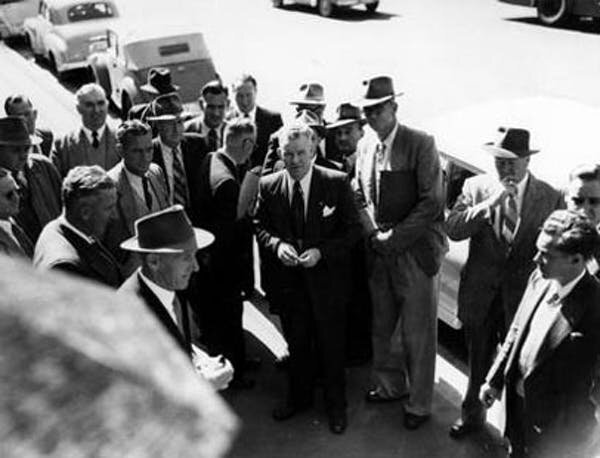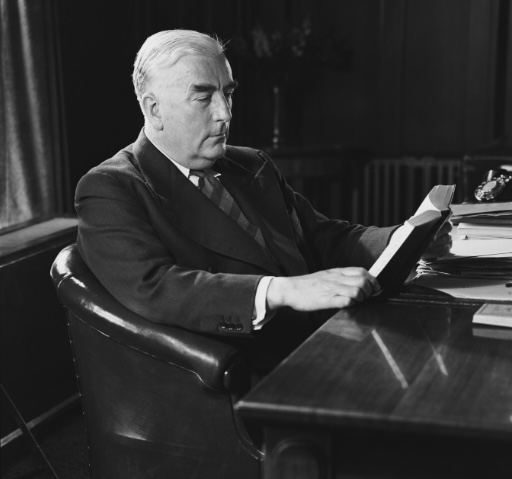On this this day, 27 August 1957, Tasmanian Senator George Cole informed the Senate that the Australian Labor Party (Anti Communist) had officially changed its name to the Democratic Labor Party. It was under this name that the DLP would direct crucial preferences to the Coalition in numerous elections, helping to turn the Menzies Government into the Menzies era. For example, in 1958 the Liberals held 16 seats on DLP preferences, in 1961 they held 24, and in 1963 they held 17. In 1961 in particular, these preferences proved crucial to the Government holding on with a slim majority of 62 seats to the Labor Party’s 60. In his retirement Menzies would repay the favour, openly admitting to voting for the DLP over the Liberal Party as he was disillusioned with the latter’s leadership and direction. Whether this reflected an increasing conservatism in Menzies’s latter years or a leftward drift of the Liberal Party itself is open to debate.
The DLP was ultimately the product of the infamous Labor Party split of 1954-55. This was the third great split in the party’s federal history, following splits over conscription during the Great War and over economic policy during the Great Depression. Prior to Federation there had also been major splits over tariff policy and the introduction of Labor’s caucus pledge. Joseph Cook, the first non-Labor leader to win an outright majority at a federal election, had been a former leader of the Labor Party in New South Wales before leaving over the pledge and joining George Reid’s Free Trade Government.
The split of 1954-55 was ostensibly fought over attitudes towards communism. From the late 1930s and into the 1940s members of the Communist Party had managed to get themselves elected to important positions within the trade union movement. In response, State Labor branches had established Industrial Groups to try to wrest these positions from the communists. In Victoria, this cause was taken up enthusiastically by a group of Catholic anti-communists centred around B.A. Santamaria and the Catholic Social Studies Movement. Catholicism and communism were incompatible creeds because of the ideological atheism of the latter, and this gave great motivation to members of ‘the Movement’.
By the 1950s ‘the Movement’ had become so successful that there were accusations that it was trying to take over the Victorian branch of the Labor Party and dictate its policy. The truth and extent of this has been the subject of much historical debate, though certainly Santamaria had developed quite a coherent political philosophy that he wished to propagate. Federal Labor Leader Dr H.V. Evatt, who had a conspiratorial mindset demonstrated most clearly in his reaction to the Petrov affair, took an extreme view towards these allegations. He blamed his 1954 election loss on ‘a small minority of members, located particularly in the State of Victoria’ who sought to undermine him. By early 1955 the situation had escalated such that the ALP Federal Executive dissolved the Victorian State Executive, and there were spectacular scenes when that dissolved executive attempted to nevertheless take up its position at the Federal Conference in Hobart.
Menzies called an early election to capitalise on his opponent’s disarray and won in a landslide. The split destroyed Labor Governments in both Victoria and Queensland, though in the other States its effects were somewhat mitigated. The split reflected sectarian hostilities that were a pervasive part of Australian society at the time, and helped to dislodge many Catholic voters from a long-standing association with the Labor Party. Combined with the greater social mobility created by the prosperity of the Menzies era and Menzies’s later olive branch to Catholics over state aid, the split helped precipitate many Catholics beginning to vote for centre-right parties, reversing a trend that had roots as far back as Henry Parkes’s exploitation of sectarian issues.
The DLP have often been characterised as extremely socially conservative. This is true in some respects, but the centrality of anti-communism to their political creed also created some important policy innovations. Most remarkably, as early as 1957 the party’s annual conference came out in opposition to the White Australia Policy, at a time when this maintained the support of both major parties. The resolution rejected any migration policy permitting discrimination on the grounds of race or colour, and was inspired in part by a feeling of solidarity with those Asian peoples struggling in fights against communism at the time.
Further Reading:
Brian Costar & Peter Love, The Great Labor Schism: A Retrospective (Scribe Publishing, 2005).
Gerard Henderson, Santamaria: A Most Unusual Man (Melbourne University Press, 2015).
P.L. Reynolds, The Democratic Labor Party (Jacaranda Press, 1974).
Sign up to our newsletter
Sign up for our monthly newsletter to hear the latest news and receive information about upcoming events.


